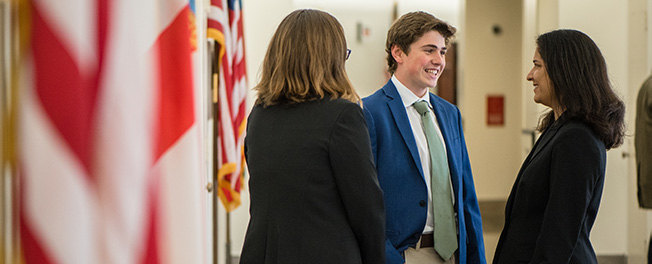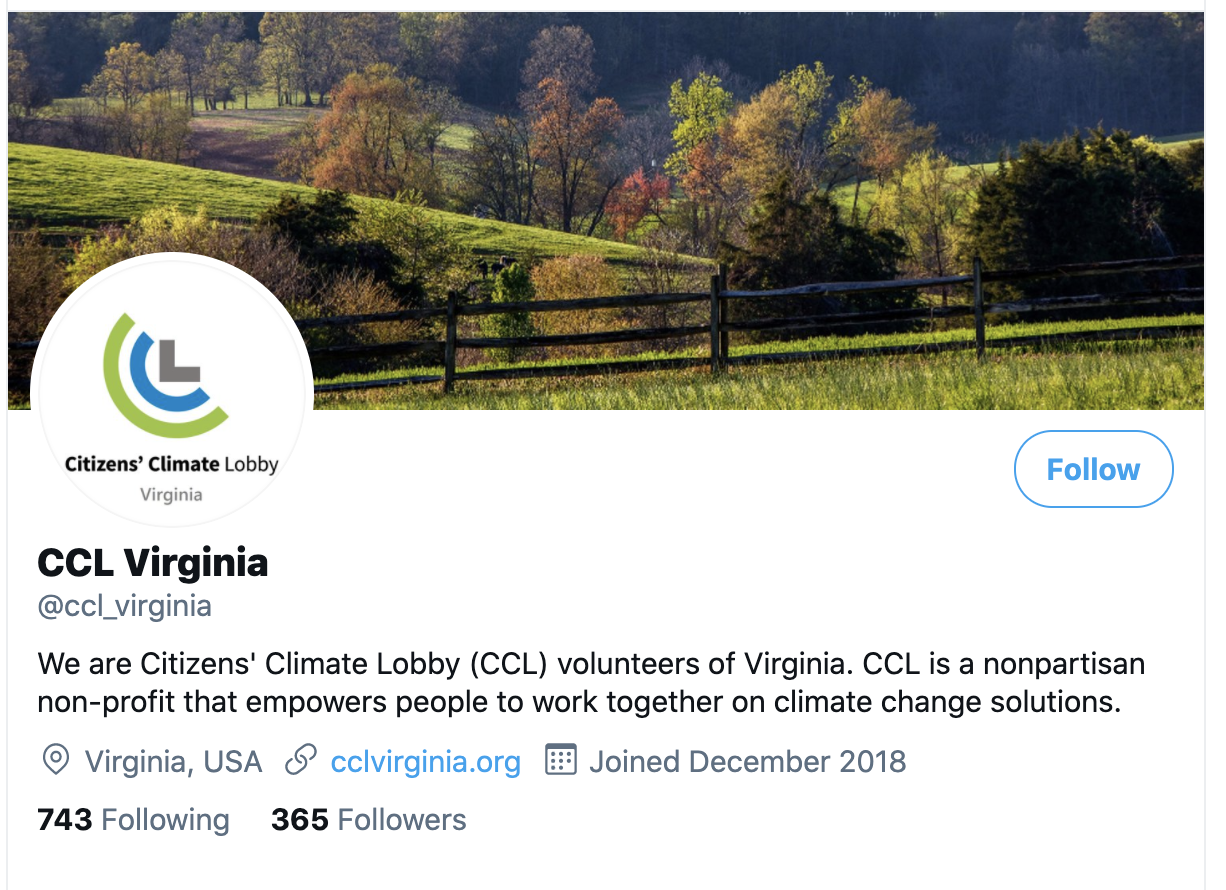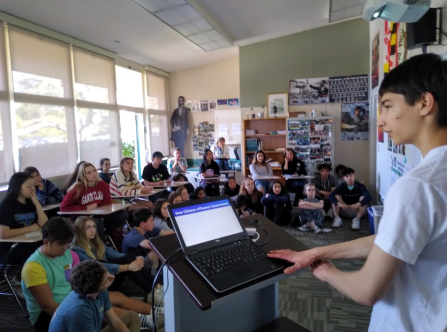
CCE in the Virtual Classroom
“I didn’t know it was so easy to write to Congress,” said a high school student after a youth outreach presentation at the Pinewood School in Los Altos Hills, California. CCL youth have seen how their presence in community presentations empowers others toward meaningful climate action, and ever since the announcement of the CCE in the Classroom effort in September of 2020, the youth of CCL have continued to double down on their efforts.
Lanier Poland is a high school senior and a member of the Silicon Valley North Youth Action Team who gave one of a series of online 2020 Earth Week presentations hosted by her chapter. Urging activists to not get discouraged by the shift to online presentations, she and her presentation partner reached a national audience last April that included active CCLers and high school students who were exploring new ways to get involved in the climate movement. “Not only do you not have to travel to give these presentations to groups of people,” she explained, “but you can reach… broader audiences that you wouldn’t normally be able to reach.”
She also emphasized the tools available online to “make your presentations more interesting and help people understand it better.” From Kahoot! games to interactive Zoom polls, Lanier and her team worked to ensure their presentations went beyond a speech on a call, and she encourages other presenters to do so as well.
Sofia Gore is a member of the North Carolina Triangle Youth Action Team who has presented to high school classrooms in North Carolina, California, and Texas. For her, maintaining audience attention with activities was a critical aspect of her presentations. She emphasized the importance of using a variety of tools, such as games, videos, and open-ended questions. “Just a little bit of everything,” she remarked.
Preparation
Like many youth presenters, Sofia stressed the importance of preparation, especially given the anxiety of presenting to unfamiliar audiences. “I’d never really done presentations other than when I was forced to in school,” said Sofia. “The first [CCL presentation] was very, very stressful.” To her, preparation is key to a confident presentation. “I look at the speaker notes, and I copy and paste [them] into a separate document. Then I edit the speaker notes just a little bit if I feel like I need to.”
Other presenters have taken a different approach to preparation. Tal Dickman, a member of the Silicon Valley North Youth Action Team, has changed his pre-presentation ritual over time. “I used to memorize scripts,” Tal said. But after receiving advice from CCL Presenters Action Team lead Dave Cain, he made some changes. “He gave the advice to never use a script,” said Tal. Tal has since changed his strategy. “As long as I focused on the general ideas and transitions I wanted to get across, I felt prepared.”
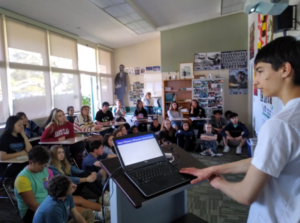
Kiran Garewal presenting at Pinewood Highschool before the switch to virtual classrooms.
Toolkits and Packages
While preparing to give their own series of presentations, the members of the North Carolina Triangle Youth Action Team found a few resources, including presentation toolkits. One particular toolkit, the DIY Climate Presentation Package, was created by members of the Silicon Valley North Youth Action Team. It includes sample presentations and on-demand guidance from the members of that youth team. “When I first heard about the [DIY] presentation package, I was impressed,” said Sydney Mason, one of the youth involved in the presentations in North Carolina. Mason was especially awed by the effort the California youth put into preparing the toolkit. “I thought that the care that had been put into this package was admirable,” she said.
The presentation toolkit from the Silicon Valley North Youth Team isn’t the only one out there. Several members of the National Youth Action Team and the Presenters Action Team had previously created their own youth presentation starter kit. “Folks in California thought that empowering students to make presentations was a great way to do Grassroots Outreach,” said Sharon Bagatell, who currently leads the Youth Action Team. The goal was to help youth across the country “find an important role to play in CCL” by “providing a youth-oriented slide deck and some guidance on planning and giving a presentation.”
“It’s wonderful to see youth turning the challenges of pandemic-time virtual learning into an opportunity to do national outreach,” said Sharon, “and it’s great to see how youth teams in different areas can create their own presentations, yet at the same time collaborate to build the outreach. I’d love to see even more online presentations by even more youth teams happen in the coming year!”
Newfound Confidence
Tal noted the confidence he gained from presentations. As he put it, he encouraged fellow presenters to “fake it till you make it.” He and Lanier both shared that giving presentations allowed them to increase their confidence in speaking, as well as in the material they presented about. Specifically, Lanier noted that the details of HR 763 that she learned for the presentations have since proven useful in the letters to the editor and op-eds she has written.
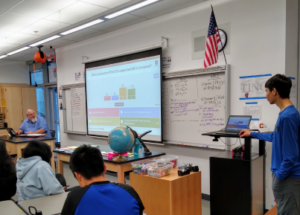
Student presenters included Kahoot! Games as a tactic to keep high schoolers engaged in presentations.
Spurred Into Action
Not only do outreach presentations give the presenters an opportunity to practice and sharpen their explanatory skills, but they also helped galvanize the attendees into joining the climate movement.
“It was alarming to see the general statistics that were brought up in the presentation and some of the things that… they talked about in terms of how bad our climate is now and how much we should be stepping in,” said Madelyn Stone, a member of the Silicon Valley North Youth Team who joined after attending Tal’s presentation. While Madelyn was aware of climate change’s existence, Tal’s presentation spurred her to join CCL to do her part.
Soeun Son, a member of Washington Youth CCL, was also inspired by a presentation she saw. “I first heard about CCL through a local King County Library System program.” She said that the Washington presenters’ detailed explanations about the Energy Innovation Act showed her how effective the legislation could be. “They were really specific about how we can get involved as well.” Among other things, Soeun now works in grasstops outreach with the Washington team and has even given presentations to local businesses.
Another Earth Week presentation attendee and current Silicon Valley North chapter member, Jack Rosenberg, stressed the importance of CCL’s presence. While many climate advocacy groups exist, Jack shared that whoever takes the time to present in the community and to follow up with interested attendees will end up seeing the newest members. If CCL wants to continue to gain strongly motivated, passionate youth, it’s crucial that chapter members continue to reach out to students in the ways that are most accessible to them. Otherwise, most prospective climate advocates will remain prospective.
Additional Resources
If you want to get started with your own online presentations in your communities, you’re not alone! Check out the following resources to help you do so:
- DIY Climate Presentation Package, developed by the Silicon Valley North team
- Youth Presentation Starter Kit, prepared by members of the National Youth Action Team and Presenters Action Team
- Giving a Presentation training page, available on CCL Community
Kiran Garewal is a high school senior and a member of the Silicon Valley North chapter of CCL.
James Li is a student at the North Carolina School of Science and Mathematics and a member of the NC Winston-Salem chapter. They have both been highly active in youth climate activism and have given youth presentations to nationwide audiences with their teams. They wrote this piece as part of CCL’s Youth Blog Writing Team.


